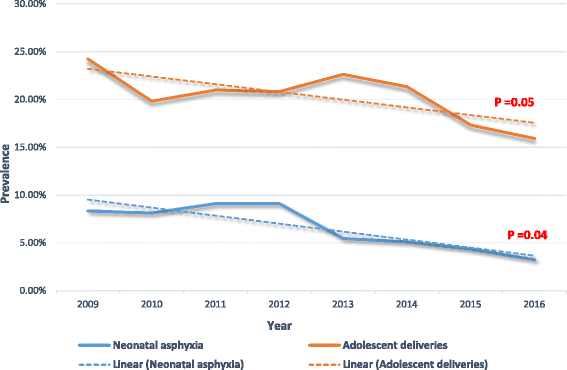Adolescent deliveries in rural Cameroon: an 8-year trend, prevalence and adverse maternofoetal outcomes
- PMID: 28962649
- PMCID: PMC5622552
- DOI: 10.1186/s12978-017-0382-6
Adolescent deliveries in rural Cameroon: an 8-year trend, prevalence and adverse maternofoetal outcomes
Abstract
Background: Adolescent deliveries remain a global public health concern especially in low- and middle-income countries where 95% of these deliveries occur. In Cameroon, adolescent pregnancies have a high disease burden due to their association with adverse pregnancy outcomes. We sought to evaluate the prevalence, trend and adverse maternofoetal outcomes of adolescent deliveries in a rural community in Cameroon.
Method: We carried out a retrospective register analysis of 1803 singleton deliveries in two health facilities located in the Oku sub-division over an 8-year period (2009 to 2016). We excluded: records without maternal age, babies born before arrival, birthweights less than 1000 g, multiple deliveries and deliveries before 28 weeks gestation. Data analysis was done using Epi info 7.0.8.3. The Fisher's exact test was used to compare categorical variables, while the chi-square test for trends was used to determine time trends. P-values below 5% were considered statistically significant.
Results: The 8-year prevalence of adolescent deliveries was 20.4% (95% CI = 18.6-22.4) with a significant, downward trend between 2009 and 2016 (P trend = 0.05). Second-fourth degree perineal tears were more likely to complicate adolescent (Age < 20 years) deliveries compared with their adult (Age ≥ 20 years) counterparts (OR = 2.9; 95% CI = 1.8-4.7; p < 0.001). Also, babies born to adolescent mothers were more likely to have a low birthweight (OR = 1.7; 95% CI = 1.1-2.6; p = 0.009) and be asphyxiated at the fifth minute of life (OR = 3.2; 95% CI = 1.9-5.5; p < 0.001). Over an eight-year period, the downward trend in the prevalence of adolescent deliveries was associated with a significant decrease in the trend of neonatal asphyxia at the fifth minute. Married adolescents and their babies were as likely to develop the complications of adolescent delivery such as second-fourth degree perineal tears (OR = 0.8; 95% CI = 0.4-1.6; p = 0.456), low birthweight (OR = 2.1; 95% CI = 0.9-4.7; p = 0.070) and fifth minute neonatal asphyxia (OR = 0.9; 95% CI = 0.4-2.0; p = 0.832) as single adolescents and their babies.
Conclusion: The prevalence of adolescent deliveries in this rural community is high with one of every five babies born to an adolescent mother. Despite the downward trend indicating a decrease in adolescent deliveries, our study demonstrates the need to reinforce and effectively apply existing government-based public health programme to target key indicators of adolescent pregnancy in Cameroon.
Keywords: Adolescent deliveries; Adverse maternal and foetal outcomes; Rural Cameroon.
Conflict of interest statement
Ethics approval and consent to participate
Ethical approval was obtained from the scientific and ethical review board of the Northwest Regional delegation for Health.
Consent for publication
Not applicable.
Competing interests
The authors declare that they have no competing interests.
Publisher’s Note
Springer Nature remains neutral with regard to jurisdictional claims in published maps and institutional affiliations.
Figures
Similar articles
-
Adolescent Deliveries in a Secondary-Level Care Hospital of Cameroon: A Retrospective Analysis of the Prevalence, 6-Year Trend, and Adverse Outcomes.J Pediatr Adolesc Gynecol. 2016 Dec;29(6):632-634. doi: 10.1016/j.jpag.2016.05.011. Epub 2016 Jun 1. J Pediatr Adolesc Gynecol. 2016. PMID: 27262835
-
Low birthweight in rural Cameroon: an analysis of a cut-off value.BMC Pregnancy Childbirth. 2018 Jan 15;18(1):30. doi: 10.1186/s12884-018-1663-y. BMC Pregnancy Childbirth. 2018. PMID: 29334919 Free PMC article.
-
Adolescent deliveries in urban Cameroon: a retrospective analysis of the prevalence, 6-year trend and adverse outcomes.BMC Res Notes. 2018 Jul 13;11(1):469. doi: 10.1186/s13104-018-3578-0. BMC Res Notes. 2018. PMID: 30005713 Free PMC article.
-
Prevalence of adolescent deliveries and its complications in Cameroon: a systematic review and meta-analysis.Arch Public Health. 2020 May 5;78:24. doi: 10.1186/s13690-020-00406-1. eCollection 2020. Arch Public Health. 2020. PMID: 32391147 Free PMC article. Review.
-
Prevalence, indications and neonatal complications of caesarean deliveries in Cameroon: a systematic review and meta-analysis.Arch Public Health. 2020 Jun 3;78:51. doi: 10.1186/s13690-020-00430-1. eCollection 2020. Arch Public Health. 2020. PMID: 32514347 Free PMC article. Review.
Cited by
-
The adverse maternal and perinatal outcomes of adolescent pregnancy: a cross sectional study in Hebei, China.BMC Pregnancy Childbirth. 2020 Jun 1;20(1):339. doi: 10.1186/s12884-020-03022-7. BMC Pregnancy Childbirth. 2020. PMID: 32487101 Free PMC article.
-
Intimate partner violence during pregnancy against adolescents in sub-Saharan Africa: a systematic review.Inj Prev. 2024 May 20;30(3):177-182. doi: 10.1136/ip-2023-044985. Inj Prev. 2024. PMID: 38195654 Free PMC article.
-
Adolescent pregnancy outcomes at Queen Elizabeth Central Hospital, Malawi: a cross-sectional study.Malawi Med J. 2021 Dec;33(4):261-268. doi: 10.4314/mmj.v33i4.6. Malawi Med J. 2021. PMID: 35291391 Free PMC article.
-
Sexual and reproductive health of CDC plantation camp residents: a focus on unmet need for family planning among women in union.BMC Public Health. 2023 Jan 28;23(1):193. doi: 10.1186/s12889-023-15114-y. BMC Public Health. 2023. PMID: 36709297 Free PMC article.
-
Adolescent deliveries in rural Cameroon: comparison of delivery outcomes between primipara and multipara adolescents.BMC Res Notes. 2018 Jul 3;11(1):427. doi: 10.1186/s13104-018-3550-z. BMC Res Notes. 2018. PMID: 29970162 Free PMC article.
References
-
- WHO. Adolescent pregnancy. WHO. [cited 2016 Nov 27]. Available from: http://www.who.int/mediacentre/factsheets/fs364/en/
-
- INS/Cameroun IN de la Santé, International ICF . Cameroun Enquête Démographique et de Santé et à Indicateurs Multiples (EDS-MICS) 2011. 2012.
-
- Egbe TO, Omeichu A, Halle-Ekane GE, Tchente CN, Egbe E-N, Oury J-F. Prevalence and outcome of teenage hospital births at the buea health district, South West Region, Cameroon. Reprod Health. 2015;12 [cited 2016 Nov 28] Available from: http://www.ncbi.nlm.nih.gov/pmc/articles/PMC4690316/ - PMC - PubMed
MeSH terms
LinkOut - more resources
Full Text Sources
Other Literature Sources
Medical


